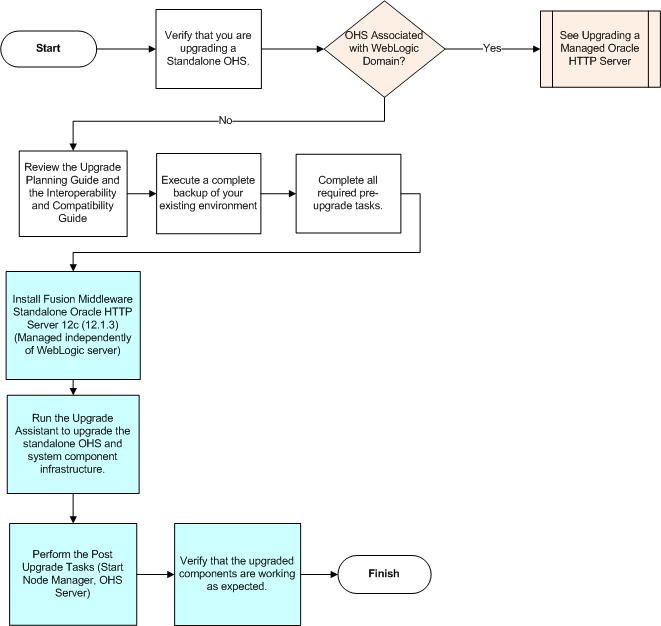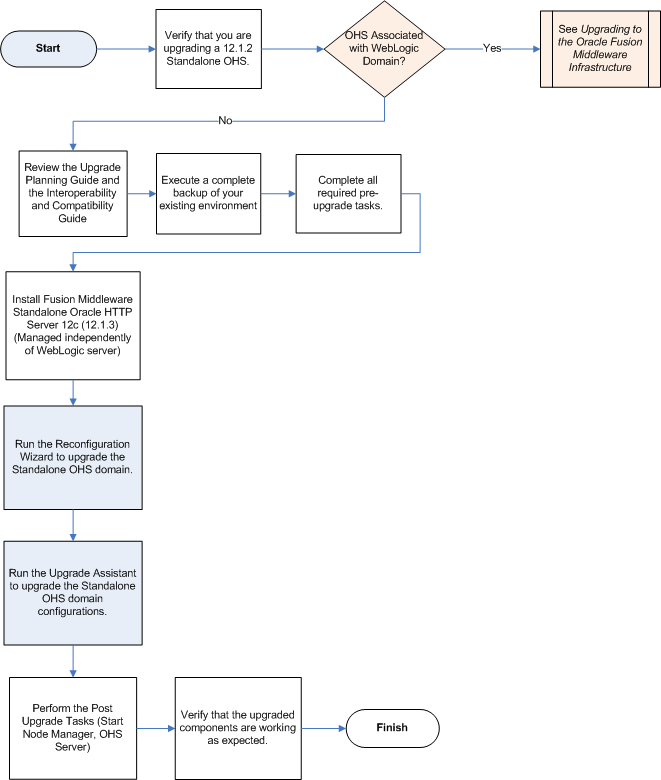2 Introduction to the Standalone Oracle HTTP Server Upgrade
Caution:
This section should be used to upgrade an Oracle HTTP Server that is NOT managed through a WebLogic Server domain.
If your Oracle HTTP Server is managed through Oracle WebLogic, then follow the procedure in Upgrading a Managed Oracle HTTP Server .
This chapter includes the following sections:
- Understanding the Standalone Oracle HTTP Server Topology
In 12c, a standalone Oracle HTTP Server is not managed by or registered to an Oracle WebLogic Server domain. A standalone Oracle HTTP Server 12c topology is installed and configured without the Oracle Fusion Middleware Infrastructure. A managed Oracle HTTP Server, however, is associated with an existing Oracle WebLogic Server domain. For the standalone scenario, you install the Oracle HTTP Server software in its own Oracle home, and you configure the Oracle HTTP Server instance in its own standalone domain. - Overview of the Standalone Oracle HTTP Server Upgrade Process
The valid starting points for upgrading the Oracle HTTP Server are 11g Release 11.1.1.7 and above and 12c Release 12.1.2 and above.
2.1 Understanding the Standalone Oracle HTTP Server Topology
In 12c, a standalone Oracle HTTP Server is not managed by or registered to an Oracle WebLogic Server domain. A standalone Oracle HTTP Server 12c topology is installed and configured without the Oracle Fusion Middleware Infrastructure. A managed Oracle HTTP Server, however, is associated with an existing Oracle WebLogic Server domain. For the standalone scenario, you install the Oracle HTTP Server software in its own Oracle home, and you configure the Oracle HTTP Server instance in its own standalone domain.
Note:
-
For more information on installing and configuring a standalone Oracle HTTP Server, see Installing and Configuring Oracle HTTP Server.
-
For more information on the latest 12c standalone domain, see What Is a Standalone Domain? in Understanding Oracle Fusion Middleware.
-
For more information on the administration scenarios and key features of the Oracle HTTP Server, see Introduction to Oracle HTTP Server Administrator's Guide for Oracle HTTP Server.
-
For more information on upgrading a managed Oracle HTTP Server, see Performing the Infrastructure Upgrade in Upgrading to the Oracle Fusion Middleware Infrastructure.
Figure 2-1 shows a standalone Oracle HTTP Server topology.
Figure 2-1 Standalone Oracle HTTP Server Upgrade Topology

Description of "Figure 2-1 Standalone Oracle HTTP Server Upgrade Topology "
Table 2-1 describe the elements of this topology
Table 2-1 Description of the Elements in the Oracle Fusion Middleware Standalone Oracle HTTP Server Upgrade Topology
| Element | Description and Links to Additional Documentation |
|---|---|
|
WEBHOST |
Standard term used in Oracle documentation referring to the machine that hosts the Web tier. |
|
Standalone Domain |
A standalone domain is only created if you are upgrading from 11g to 12c. If you are upgrading from 12.1.2 or 12.1.3, then the standalone domain already exists and there is no need to create the standalone domain. The standalone domain has a directory structure similar to an Oracle WebLogic domain, but it does not contain an Administration Server or Managed Servers. The Oracle WebLogic Server Node Manager and other tools allow you to manage the standalone Oracle HTTP Server instance. For more information on standalone domains, see What Is a Standalone Domain? in Understanding Oracle Fusion Middleware. |
2.2 Overview of the Standalone Oracle HTTP Server Upgrade Process
The valid starting points for upgrading the Oracle HTTP Server are 11g Release 11.1.1.7 and above and 12c Release 12.1.2 and above.
The following sections provide a high level overview of the procedures you need to perform to upgrade your standalone Oracle HTTP Server:
- Flow Chart of the Standalone Upgrade Process from 11g to 12c
- Roadmap for Upgrading a Standalone Oracle HTTP Server from 11g to 12c
- Flow Chart of the Standalone Oracle HTTP Server Upgrade Process from a Previous 12c Release
- Roadmap for Upgrading a Standalone Oracle HTTP Server from a Previous 12c Release
2.2.1 Flow Chart of the Standalone Upgrade Process from 11g to 12c
Figure 2-2 shows the high-level procedures associated with a standalone Oracle HTTP Server upgrade when the starting point is 11g. The tools used for each step are also listed.
Detailed instructions for upgrading your standalone Oracle HTTP Server are described in Upgrading a Standalone Oracle HTTP Server from 11g to 12c .
Note:
Before starting the upgrade, you must shutdown the 11g instance.Figure 2-2 Standalone Oracle HTTP Server Upgrade from 11g to 12c

2.2.2 Roadmap for Upgrading a Standalone Oracle HTTP Server from 11g to 12c
Table 2-2 describes the tasks that must be completed to upgrade a standalone Oracle HTTP Server from 11g to 12c.
Table 2-2 Overview of the Standalone Oracle HTTP Server Upgrade Process
| Task | Description | Documentation |
|---|---|---|
|
Verify that you are upgrading a standalone Oracle HTTP Server. |
The steps in this document describe the process for upgrading a standalone Oracle HTTP Server. If you are upgrading an Oracle HTTP Server that is managed by a WebLogic server domain, the upgrade steps are different. |
To determine which Oracle HTTP Server you have in your existing environment, see For information on upgrading a managed Oracle HTTP Server, see Performing the Infrastructure Upgrade in Upgrading to the Oracle Fusion Middleware Infrastructure. |
|
Verify your system environment. |
Before beginning the upgrade, verify that the minimum system and network requirements are met. |
See Verifying Certification and System Requirements in Planning an Installation of Oracle Fusion Middleware. |
|
Obtain the Oracle HTTP Server distribution. |
To create the topology described in this guide, obtain the Oracle Fusion Middleware Oracle HTTP Server distribution. |
See Understanding and Obtaining Product Distributions in Planning an Installation of Oracle Fusion Middleware. |
|
Install the software. |
Run the installation program to install the software. Select the installation type Standalone Oracle HTTP Server (managed independently of WebLogic server). This transfers the software to your system and creates a new Oracle home directory. |
|
|
Run the Upgrade Assistant. |
After the installation, you need to use the Upgrade Assistant to upgrade the Oracle HTTP Server and system component infrastructure. |
|
|
Verify whether the upgrade is successful. |
Your Oracle HTTP Server should continue to function as expected. If you have post-upgrade issues, you will need to troubleshoot the installation and retry the upgrade. |
See Troubleshooting Oracle HTTP Server in Administrator's Guide for Oracle HTTP Server. |
2.2.3 Flow Chart of the Standalone Oracle HTTP Server Upgrade Process from a Previous 12c Release
Figure 2-3 shows the high-level procedures associated with a standalone Oracle HTTP Server upgrade when the starting point is another 12c release. The tools used for each step are also listed.
Detailed instructions for upgrading your standalone Oracle HTTP Server are described in Upgrading a Standalone Oracle HTTP Server from a Previous 12c Release.
Note:
Before starting the upgrade, you must shutdown the 12c instance.Figure 2-3 Standalone Oracle HTTP Server Upgrade from a Previous 12c release

2.2.4 Roadmap for Upgrading a Standalone Oracle HTTP Server from a Previous 12c Release
Table 2-3 describes the tasks that must be completed to upgrade a standalone Oracle HTTP Server from a previous release of 12c to the latest version.
Table 2-3 Overview of the Standalone Oracle HTTP Server Upgrade Process
| Task | Description | Documentation |
|---|---|---|
|
Verify that you are upgrading a standalone 12.1.2 Oracle HTTP Server. |
The steps in this document describe the process for upgrading a standalone Oracle HTTP Server. If you are upgrading an Oracle HTTP Server that is managed by a WebLogic server domain, the upgrade steps are different. |
For information on upgrading a managed Oracle HTTP Server, see Performing the Infrastructure Upgrade in Upgrading to the Oracle Fusion Middleware Infrastructure. |
|
Verify your system environment. |
Before beginning the upgrade, verify that the minimum system and network requirements are met. |
See Verifying Certification and System Requirements in Planning an Installation of Oracle Fusion Middleware. |
|
Obtain the Oracle HTTP Server distribution. |
To create the topology described in this guide, obtain the Oracle Fusion Middleware Oracle HTTP Server distribution. |
See Understanding and Obtaining Product Distributions in Planning an Installation of Oracle Fusion Middleware. |
|
Install the software. |
Run the installation program to install the software. This transfers the software to your system and creates a new Oracle home directory. |
|
|
Reconfiguring the domain. |
To start the Reconfiguration Wizard from 12c Oracle HTTP Server installation to perform domain-related upgrades, run the following command: On UNIX:
On Windows:
|
See Upgrading the 12.1.2 Domain using the Re-Configuration Wizard. |
|
Run the Upgrade Assistant. |
After the installation, you need to use the Upgrade Assistant to upgrade the Oracle HTTP Server and system component infrastructure. |
|
|
Verify the upgrade was successful. |
Your Oracle HTTP Server should continue to function as expected. If you have post-upgrade issues, you need to troubleshoot the installation and retry the upgrade. |
Troubleshooting Oracle HTTP Server in Administrator's Guide for Oracle HTTP Server. |